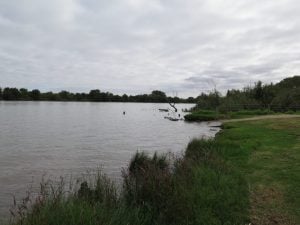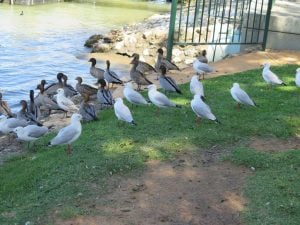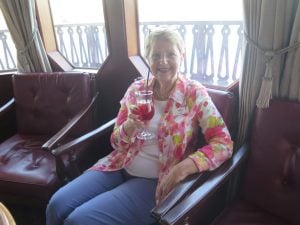A large crowd enjoyed the shade on the riverside on a very hot day at Mannum on Good Friday
25 March 2016
We only have a short drive today from Murray Bridge to Mannum (25 kms) to board the PS Murray Princess for our three day cruise. It is Good Friday so we didn’t expect to find any cafes open for breakfast, so decided to do some exploring around Murray Bridge. Firstly we drove to Monteith once a thriving dairying community, but still part of the Murray Bridge area that is rich in dairy products.
 We were eventually successful in finding the properties where a friend grew up, and a pretty park, Bells Landing Reserve, on the Murray River (right). Then we headed toward Mannum and on the outskirts of the town found a small shopping village and….a cafe that was open! Mugs of coffee, and toasties, for brunch and we were on our way to Mary Ann Park on the Murray River and our paddle steamer mode of travel for the next few days – and no driving! We had booked the car in to secure parking so all we needed to do was organise our luggage to take on board, leave the rest in the boot of the car, and we were ready to board.
We were eventually successful in finding the properties where a friend grew up, and a pretty park, Bells Landing Reserve, on the Murray River (right). Then we headed toward Mannum and on the outskirts of the town found a small shopping village and….a cafe that was open! Mugs of coffee, and toasties, for brunch and we were on our way to Mary Ann Park on the Murray River and our paddle steamer mode of travel for the next few days – and no driving! We had booked the car in to secure parking so all we needed to do was organise our luggage to take on board, leave the rest in the boot of the car, and we were ready to board.
Our first meeting with the elegant Murray Princess
This picturesque town (population 2000) has several claims to fame. It was founded by William Randell in 1852. He built Australia’s first steam boat, the Mary-Ann (named after his mother) in 1853. Mannum soon became the cradle of river trade. It was also in Mannum that the Shearer brothers developed Australia’s first motor car, which featured a differential gear in an enclosed case and fuelled by Mallee roots! The horseless carriage was then regarded as little more than a novelty, only a handful of far sighted people seeing it as a coming revelation in transport.
David Shearer’s sole aim had been to prove that a horseless carriage was a workable proposition, and with that accomplished he turned his attention to the manufacturing of farm machinery. Shearer Brothers (now Horwood Bagshaw Ltd) remains today producing quality farm/agricultural products. Cereal crops and sheep production are still strong industries in the area. Mannum’s main attraction is still the river, with many boats on the river and water from the river used for agriculture. In 1954 an 84km pipeline was completed between Mannum and Adelaide to supply water for metropolitan Adelaide.
The rotunda beside the Princess (left) and the seagulls and ducks at their afternoon get together
The Murray River was first discovered by European explorers Hamilton H Hume and William H Hovell in 1824. It wasn’t until five years later, however, that Charles Sturt navigated down the Murrumbidgee to encounter the Murray and named it after Sir George Murray, when his exploration party encountered the Darling connection.
Paddle steamers were used to carry wool, wheat, and other goods up and down the river system including the Murray, Darling and Murrumbidgee Rivers. Since settlement of the river basin was so late, the introduction of the railroad came much sooner to the river towns and had a large impact on the steamers along the Murray. Irrigation was introduced in 1887 by Canadian George Chaffey around Mildura (Victoria) and Renmark (South Australia). This greatly accelerated settlement and exploitation of the river’s water supply.
In 1918, a commission was formed to manage water supply and it also coordinated the construction of storages, locks ad weirs to reduce the effects of drought and flood. Today, the water flow is still managed by these locks on the river from Yarrawonga in Victoria to Blanchetown (Lock 1) in South Australia. Millions of people rely on the Murray as a source of water for domestic and industrial use and it plays a significant part in Australia’s economy.
A large amount of species can be found living in the river basin, including emus, koalas, Western Grey kangaroos, Bearded Dragon lizards, red-rumped parrots, black swans, pelicans, and even dolphins (closer to the ocean). Also plentiful are fish such as the Murray Cod, Bream, Perch, and Redfin.
The paddle steamer did not leave for a few hours, so we had time to explore the main street of Mannum, again with some lovely old heritage buildings (below left and right), a walk along the foreshore park, and a rest in the old rotunda in the shade. Although the day had started with cloud, by the time we reached Mannum the sun was out and it would have been extremely hot without the cool breeze coming off the river.
At 2.30pm we were permitted to board, walking on the red carpet onto the ship and being welcomed by the captain and crew (below). After leaving our luggage to be delivered to our cabin, we were given directions to the secure parking a short drive away. It was so nice to be able to unpack some clothes (all freshly washed at Mt Gambier) and put them neatly in the wardrobe and drawers. The cabins are small (although twice the size of those on the Indian Pacific and The Ghan trains) and we soon felt quite at home.
At 4.30pm the whistles blew, the ropes were untied, the paddles started spinning – and we were off. We had a safety briefing and orientation on facilities available on the boat, then drinks at 6pm (Cocktail of the Day) and dinner at 6.30pm with a glass of red wine – and I was ready for bed! There is only one TV on board and internet availability is weak – bliss!!
The crew work very hard on board the Princess, and long hours. There are always activities for those who are interested, and the crew provide all the entertainment, including preparing to toast marshmallows after dinner on our first night (below left). The jet skis love the Princess, and there were always two or three “surfing” the wash from the paddles (below right)!
Tonight we sailed from Mannum, mooring at Murunda, and tomorrow we move on to Murray Bridge. The ship moves faster than I imagined, and very smoothly. The river was alive being the Easter weekend and I was amazed at the number of houses along the riverbank, the houseboats (some very luxurious, see left), the speedboats, canoes and skiers. It is going to be a busy weekend on the river!
Check the Tastes page here













